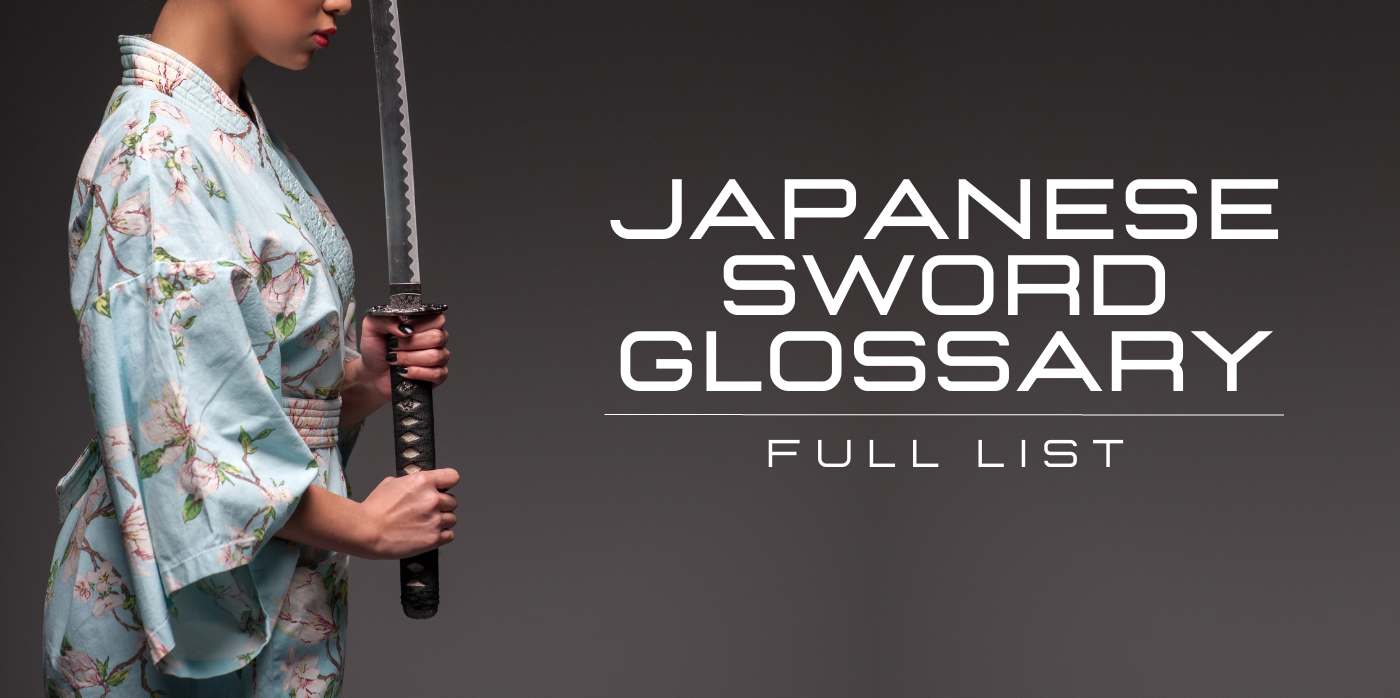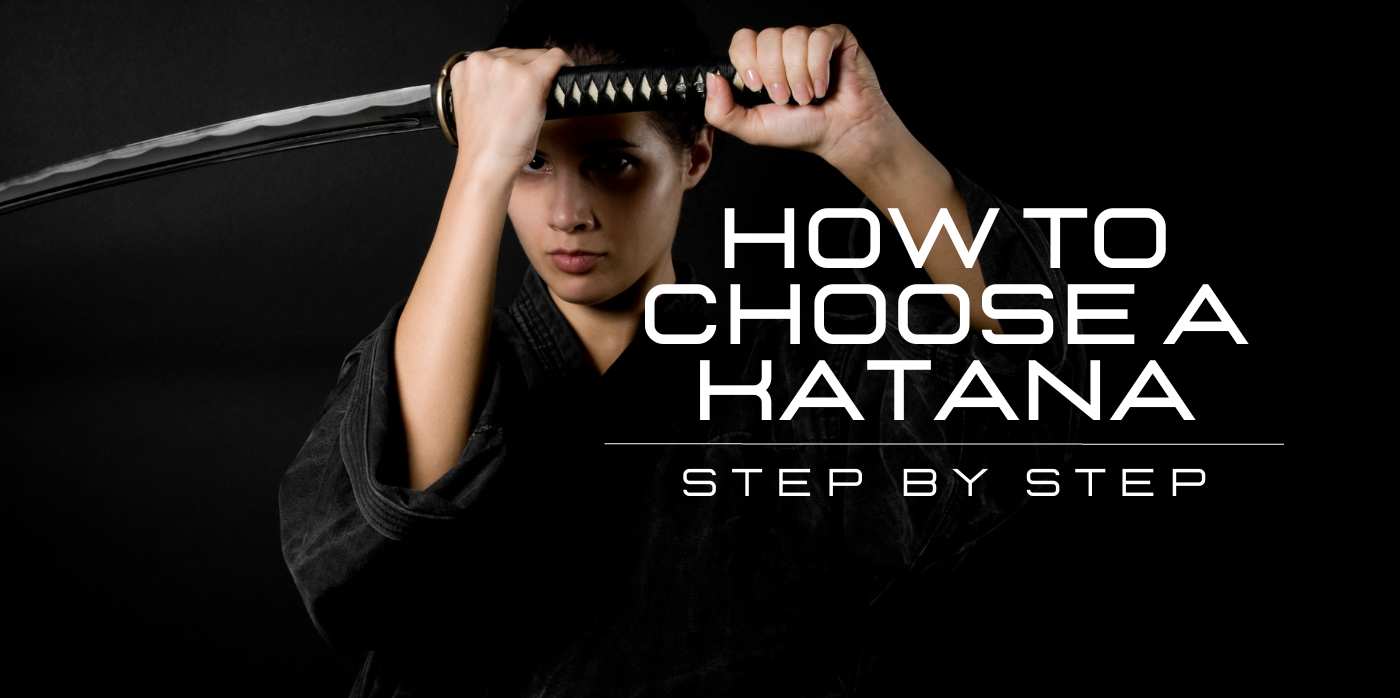This glossary will help you grasp what makes Japanese swords real works of art, whether you are a seasoned sword collector, a martial arts aficionado, or simply someone with a profound interest in Japanese culture and workmanship.
A
- ashi (足): Ashi are lines of harder steel, or temper lines, that stretch into the hardened edge in a blade.
- ayasugi-hada (綾杉肌): A grain pattern resembling waves, common in Gassan blades.
B
- bokutō (木刀): A wooden sword used for training in various martial arts.
- bōshi (帽子): The pattern made by the hardening process in the tip of a blade.
C
- chikei (地景): Lines of Nie crystals that appear to be flowing on the blade's surface.
- chokutō (直刀): An early style of straight sword.
- chōken (長剣): A long sword.
- chōtō (長刀): A long blade.
D
- daishō (大小): The set of long and short swords that a samurai wears.
- daitō (大刀): A long sword, typically over 60 cm in length.
F
- fuchi (渕): Metal cap that encases the grip (tsuka) of a Japanese sword.
- fukura (脹): The rounded area on the blade edge near the point.
- funbari (踏ん張り): The tendency of some blades to widen above the base.
G
- gassan-hada (月山肌): A grain pattern in the form of undulating waves, associated with the Gassan school.
- gendaitō (現代刀): Modern swords made after 1876.
- gokaden (五ヶ伝): The Five Traditions of Japanese swordsmithing.
- gomabashi (護摩箸): Parallel lines engraved on the blade that look like chopsticks.
H
- ha (刃): The cutting edge of the blade.
- hajimi (刃染): The transition zone between the tempered edge and the body of the blade.
- hamachi (刃区): The notch at the beginning of the cutting edge.
- hamon (刃文): The visual effect created on the blade by the hardening process.
- hasaki (刃先): The cutting edge.
- hataraki (働): Activities or effects in the hamon.
- hijiki-hada (鹿尾菜肌): A type of grain pattern resembling seaweed.
- hira (平): Flat surface of the blade.
- hiraji (平地): The flat section of the blade between the shinogi and the hamon.
- hira-zukuri (平造): A blade shape without a shinogi.
- hitatsura (皆焼): A type of hamon that covers almost the entire blade.
- hon-zukuri (本造): A traditional blade shape with a shinogi.
I
- ichimai bōshi (一枚帽子): A type of boshi where the hamon goes all the way to the edge without a turn back.
- ichimonji kaeri (一文字返り): A boshi with a straight turn back.
- ikubi-kissaki (猪首切先): A style of kissaki that is short and stout, resembling a boar's neck.
- iori (庵): A type of mune (spine of the blade) that resembles a peaked house roof.
- itame-hada (板目肌): Wood grain pattern.
J
- ji (地): The surface area between the shinogi and the hamon.
- jigane (地鉄): The soft steel forming the body of the blade.
- jihada (地肌): The grain pattern in the body of the blade.
- ji-nie (地沸え): Nie crystals in the ji.
- jōkotō (上古刀): Ancient swords made before the Heian period.
- jūka chōji (重化丁子): A type of hamon with clustered choji shapes.
- jūken (銃剣): A bayonet.
K
- kaeri (返り): The turn back of the boshi.
- kaiken (懐剣): A short dagger, often carried by women.
- kasane (重ね): Thickness of the blade.
- katana (刀): A curved, single-edged sword, traditionally used by the samurai.
- kataochi gunome (肩落ち互目): A hamon in the shape of a half-circular or semi-circular pattern.
- kawazuko chōji midare (蛙子丁子乱れ): A choji-midare hamon that looks like the shape of frog eggs.
- ken (剣): A double-edged sword.
- kinsuji (金筋): Literally "golden lines". Bright, linear streaks of nie within the hamon.
- kissaki (切先): The point of a Japanese blade.
- kōgai (笄): A spike for adjusting hair, often found in the same mountings as a sword.
- kogatana (小刀): A small utility knife that fits into a pocket on the scabbard.
- ko-itame-hada (小板目肌): Fine wood-grain pattern.
- ko-mokume-hada (小杢目肌): Small wood burl pattern.
- ko-shinogi (小鎬): A small or narrow shinogi.
- koshi-zori (腰反): A type of curvature where the deepest curve comes at the sword's waist.
- kotō (古刀): Old swords made prior to 1596.
- kozuka (小柄): A small handle, usually for the kogatana.
- Kyōhō Meibutsuchō (享保名物帳): An official list of famous swords compiled in the Kyōhō era.
M
- machi (区): Notches on the blade where the tang begins.
- masame-hada (柾目肌): Straight grain pattern.
- Masamune juttetsu (正宗十哲): The ten famous students of the swordsmith Masamune.
- matsukawa-hada (松皮肌): Pine bark pattern, a rare type of jihada.
- mei (銘): The signature of the swordsmith.
- meibutsu (名物): Famous or well-known blades.
- mekugi (目釘): A peg for securing the handle to the blade.
- mekugiana (目釘孔): The hole in the tang for the mekugi.
- midareba (乱刃): Irregular or wavy hamon.
- midare komi (乱込み): The hamon continues into the tang.
- mihaba (身幅): Width of the blade.
- mijikagatana (短刀): Short sword.
- mitsukado (三つ角): Three corners or points, often referring to the nakago jiri.
- mokume-hada (杢目肌): Wood burl grain pattern.
- motohaba (元幅): Width of the blade at the base.
- motokasane (元重 ね): Thickness of the blade at the base.
- mune (棟): The back ridge of the blade.
- munemachi (棟区): The notch on the mune at the start of the tang.
N
- nagakatana (長刀): Long sword.
- nagamaki (長巻): A type of traditionally made Japanese sword with an extra-long handle.
- naginata (薙刀, 長刀): A pole weapon with a curved blade at the end.
- nakago (茎): The tang of the sword, onto which the handle is fitted.
- nakagojiri (茎尻): The end of the tang.
- nagasa (長さ): The length of the sword blade.
- nashiji-hada (梨地肌): Pear skin grain pattern.
- nie (沸え): Bright, granular particles along the edge of the blade.
- nihontō (日本刀): Japanese sword.
- nioi (匂い): A bright, misty line in the hamon composed of minute martensitic particles.
- nioi kuzure (匂い崩): Area where the nioi line in the hamon breaks up.
- nodachi (野太刀): A large, field sword.
- notare (湾れ): Wavy hamon pattern.
O
- ōdachi (大太刀): An extremely large version of a tachi.
- ō-hada (大肌): Large hada or grain pattern.
- ō-itame-hada (大板目肌): Large wood grain pattern.
- ō-mokume-hada (大杢目肌): Large wood burl pattern.
- ōtachi (大太刀): An older style of tachi, larger in size.
S
- samegawa: Ray skin used to cover katana handle.
- sakihaba (先幅): Width of the blade near the kissaki.
- sakikasane (先重ね): Thickness of the blade near the kissaki.
- saki-zori (先反): Curvature with the deepest part near the kissaki.
- sansaku bōshi (三作帽子): The boshi styles of three famous Kamakura-era smiths (Yoshimitsu, Yukimitsu, and Masamune).
- seppa (切羽): Metal disc that resides on both sides of the sword’s tsuba (handguard) to ensure a tight and secure fit of all components of the sword's hilt.
- shin guntō (新軍刀): A style of sword used by the Japanese military, made in a Western fashion.
- shinken (真剣: A real, live-blade sword, as opposed to a practice sword.
- shinogi (鎬): The ridge line on a Japanese blade.
- shinogiji (鎬地): The area of the blade between the shinogi and the mune.
- shinogi-zukuri (鎬造): A common blade shape with a shinogi.
- shinshintō (新々刀): New-new swords, made after 1781.
- shintō (新刀): New swords, made between 1596 and 1780.
- shōtō (小刀): Short sword.
- sori (反り): The curvature of the blade.
- sugata (姿: The overall shape and form of the blade.
- suguha (直刃): A straight hamon.
- sumigane (墨鉄): Dark steel.
- sunagashi (砂流): A line of nie in the hamon that resembles flowing sand.
T
- tachi (大刀): A traditional style of Japanese sword, worn edge-down.
- tanken (短剣): A short sword.
- tantō (短刀): A small knife or dagger.
- tō (刀): Sword
- tōken (刀剣): Japanese term for sword or blade.
- torii-zori (華表反り): A type of curvature where the deepest part of the curve is in the center of the blade.
- tōsu (刀子): Small sword.
- tsuba (鍔 or 鐔): The guard at the end of the grip of bladed Japanese weapons like the katana.
- tsurugi (剣): Straight, double-edged sword; sometimes used synonymously with ken.
U
- uchi-zori (內反): An inward curvature of the blade.
- utsuri (映り): A ghostly reflection of the hamon that appears on the ji.
W
- wakizashi (脇差): A traditional Japanese sword with a shōtō blade between 30 and 60 centimeters, similar to but shorter than a katana.
Y
- yaiba (刃): The cutting edge of the blade.
- yakitsume (烧诘): A tang that is burned on instead of being properly tempered.
- yasurime (鑢目): File marks on the tang of a Japanese sword.
- yō (葉): Leaves; often used to describe patterns in the hamon.
- yokote (横手): The line separating the blade and the point of a Japanese sword.
- yoroi tōshi (鎧通し): A blade that is capable of penetrating armor.
- yubashiri (湯走): An effect in the steel that looks like running water.
Now that you know more about the katana, it's time to see which katana will suit you best with our guide to choose your katana.



